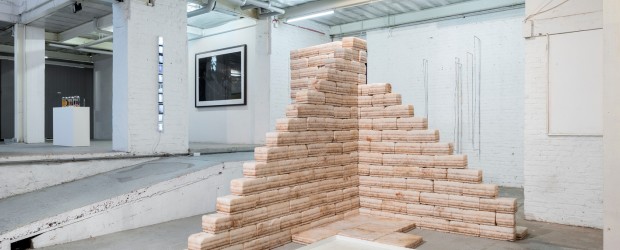Future Fossil Spaces, 2014
Future Fossil Spaces, 2014
Future Fossil Spacesis part of a global reflection of Julian Charrière on the digital era, a world of increasing dematerialization that nevertheless is grounded in the material elements of the earth. The work consists of stacks of salt bricks from the Salar de Uyuni. This salt flat, the world’s largest, located in the Bolivian Andes, holds one-third of the world’s lithium reserves, and remains largely unexploited. It is likely that this place will become the main production site of this precious element as our dependence on lithium-based technology keeps growing. Lithium is mainly concentrated in brine––water containing a high amount of salt––found under the surface salt bed. Brine is pumped, stocked in settling ponds carved out of the salt crust, where its concentration rises for a year by evaporation, before lithium is harvested. It’s these salt blocks that Julian Charrière has transported, cut and piled up in the gallery. Each brick stacked on top of another resembles the age lines of strata, reminding the viewer of the lengthy geological processes which lead to these resources as juxtaposed against the potential rapid destruction of this environment.
In this sense, the work’s title, Future Fossil Spaces, refers to future negative spaces that will be carved in the earth by these mining operations, effectively demonstrating how the enlargement of the virtual world requires a hollowing-out of the world of natural resources.
Julian Charrière (CH)
°1987
Julian Charrièreis a French-Swiss artist based in Berlin, Germany, whose work bridges the realms of environmental science and cultural history. Marshaling performance, sculpture, and photography, his projects often stem from fieldwork in remote locations with acute geophysical identities such as volcanoes, ice fields, and radioactive sites. His oeuvre explores post-romantic constructions of “nature,” staging tensions between deep or geological timescales and those relating to mankind. Creating works while exploring ecological and environmental issues in specific locations, Charrière examines how humanity interrelates with the natural order.
Born in Morges, Switzerland, Charrière currently lives and works in Berlin. A former student of Olafur Eliasson and participant of the Institut für Raumexperimente (Institute for Spatial Experiments), Charriére has exhibited his work – both individually and as a part of art collective Das Numen – at museums and institutions worldwide, amongst which the Musée des Beaux-Arts de Lausanne; Haus der Kulturen der Welt in Berlin; Kunsthalle Wien; Thyssen Bornemisza Art Contemporary in Vienna; Neue Nationalgalerie in Berlin; The Reykjavik Art Museum; the Museum of Contemporary Art in Tokyo; and many more. In 2017, Charrière’s work was featured in the 57th edition of La Biennale di Venezia.



